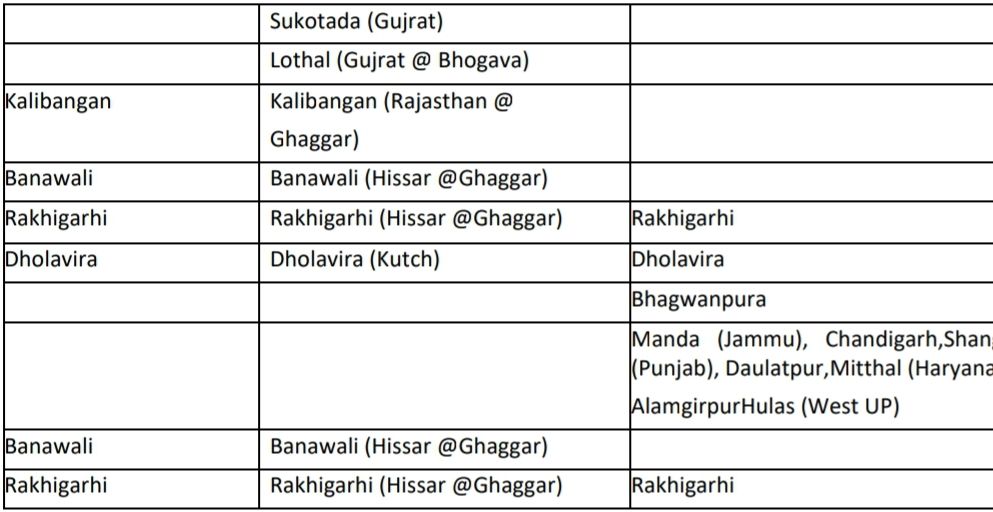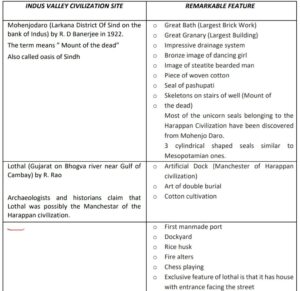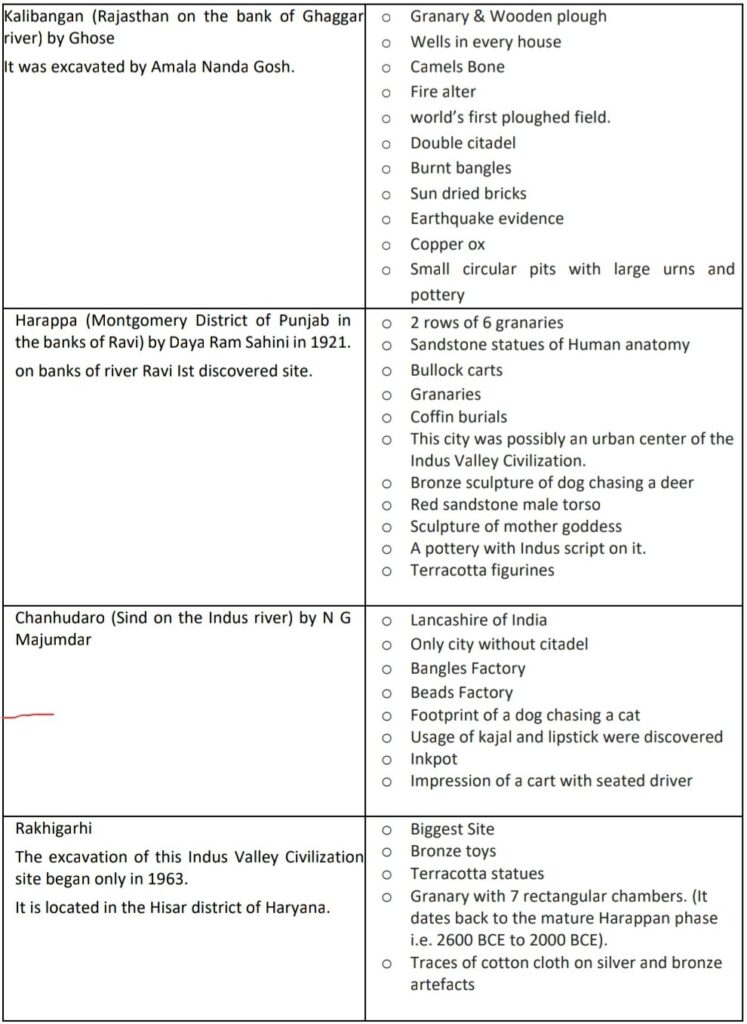INTRODUCTION
The Indus Valley Civilization was the first major civilization in South Asia, covering a large area of about 12 lakh square kilometers in present-day India and Pakistan.
Its mature phase lasted from around 2700 BCE to 1900 BCE, approximately 800 years. However, the early stages of this civilization existed even before 2700 BCE.
In the 1920s, the Archaeological Department of India excavated the Indus Valley and discovered the ruins of two ancient cities, Mohenjodaro and Harappa.
In 1924, John Marshall, the Director-General of the Archaeological Survey of India (ASI), officially announced the discovery of this civilization to the world.
The civilization’s area stretched from the Ghaggar-Hakra Valley in the east to the Makran coast of Balochistan in the west and from Afghanistan in the northeast to Daimabad in Maharashtra in the south.
Features of the Indus Valley Civilization:
The civilization is most commonly dated to 2500–1750 BCE based on carbon dating.
John Marshall was the first scholar to call it the “Indus Civilization.”
It belongs to the Proto-Historic period, specifically the Chalcolithic or Bronze Age.
The Indus Valley Civilization is also called the Harappan Civilization because Harappa, located in Punjab (now in Pakistan), was the first city to be discovered.
Evidence of an earlier civilization, called the Pre-Harappan Civilization, was found at Mehrgarh in Pakistan. This site provides the earliest evidence of cotton cultivation.
Geographical Spread of the Indus Valley Civilization:
The civilization covered regions of Punjab, Sindh, Balochistan, Rajasthan, Gujarat, and western Uttar Pradesh.
It stretched from Sutkagengor (Balochistan) in the west to Alamgirpur (western Uttar Pradesh) in the east, and from Manda (Jammu) in the north to Daimabad (Ahmednagar, Maharashtra) in the south.
Some sites of this civilization were also found in Afghanistan and Turkmenistan.
The total area covered by the Harappan Civilization was about 1,250,000 square kilometers—over 20 times larger than ancient Egypt and more than 12 times larger than the combined areas of Egypt and Mesopotamia.
Large Cities and Their Sizes:
Mohenjo Daro (Pakistan): Over 250 hectares
Harappa (Pakistan): Over 150 hectares
Kalibangan (Rajasthan): Over 100 hectares
Dholavira (Gujarat): Over 100 hectares
Ganweriwala (Pakistan): Around 80 hectares
Rakhigarhi (Hisar, Haryana): Around 80 hectares
Geographical Area of the Indus Valley Civilization:
The large cities were surrounded by vast agricultural lands, rivers, and forests. These areas were home to scattered farming communities, pastoralists, hunters, and food gatherers.
Excavations at sites like Mohenjo Daro, Harappa, Kalibangan, Lothal, Surkotada, and Dholavira have provided valuable insights into the civilization’s town planning, economy, technology, religion, and more.
Capital Cities: Harappa and Mohenjo Daro
Port Cities: Lothal, Sutkagendor, Balakot, etc.
Characteristics of the Indus Valley Civilization:
The streets and buildings in the cities were aligned with the cardinal directions (east-west and north-south), which was a unique feature of the Indus-Saraswati cities.
Cities like Mohenjo Daro, Harappa, Kalibangan, and Surkotada had large gateways at multiple entry points. These gateways were also present within the inner fortified areas of the cities.
Great Bath of Mohenjo Daro:
The Great Bath is one of the most notable features of any Harappan site.
It was a brick structure measuring 12 meters by 7 meters, with a depth of about 3 meters from the surrounding pavement.
The bath was likely used for ritual bathing, a practice common in Indian culture from ancient times to the present.
To the west of the Great Bath, there was a cluster of brick structures connected by narrow lanes. These have been identified as granaries, used for storing grains.
Similar structures have also been found at Harappa, Kalibangan, and Lothal.
Dockyard at Lothal:
Lothal had an important dockyard, which was a large structure with an inlet channel on the eastern wall and a spillway.
The inlet channel was connected to a river, allowing ships and boats to load and unload trading goods.
Lothal was a major trading hub of the Harappan civilization.
Streets and Drains in the Harappan Civilization:
One of the most remarkable features of the Harappan cities was their well-planned streets and drainage system.
The streets intersected at right angles.
This shows that the people valued cleanliness and had a strong sense of health and hygiene.
The drains were made using burnt bricks.
Harappan Crafts and Industries:
The Harappan Civilization is known as a Bronze Age civilization because they used bronze, an alloy of copper and tin.
Developments in the Indus Valley Civilization:
Cities had a citadel (acropolis) for the ruling class, while common people lived in brick houses below the citadel.
The roads were built in a grid pattern, intersecting at right angles.
Burnt bricks were widely used for construction, and there were no stone buildings in the civilization.
The people of the Indus Valley had advanced agricultural techniques but did not use a ploughshare. They grew crops like wheat, rice, barley, and peas and domesticated many animals.
They used pictographic writing, which has not been understood yet.
They used weights for trade, mostly in multiples of 16, and used bronze sticks for measurements.
They were skilled at making pottery using a potter’s wheel.
One of their greatest artistic creations was seals.
They mostly used limestone for making sculptures.
Seals of the Indus Valley Civilization:
The seals were engraved with pictographic writing, written from right to left, and it has not been decoded yet.
Most of the seals were made from steatite (a soft stone), but some were also made from terracotta, gold, ivory, and other materials. They were mainly used for trade and commerce.
The seals were also used as amulets to protect against evil.
Famous seals include Pashupati, a humped bull, elephant, and rhinoceros (found in Mohenjo Daro).
Indus Valley seals have been found in Mesopotamia, suggesting trade between the two civilizations.
Most seals were made from steatite, with a few made from gold, ivory, agate, terracotta, chert, and faience.
Arts and Sculpture:
The Indus Valley people created a variety of art objects like seals, stone statues, and terracotta figures.
Notable sculptures include a red sandstone torso (Harappa) and a bust of a bearded man made from steatite (Mohenjo Daro).
Bronze casting was widely used.
The red sandstone torso from Harappa had detachable limbs and a head.
A famous dancing girl statue about 11.5 cm tall, made of bronze, was found at Mohenjo Daro.
Terracotta in the Indus Valley Civilization:
Terracotta is clay that is baked in fire and made by hand.
Examples include Mother Goddess figurines and toy carts with wheels.
The terracotta statues of humans are simpler and less detailed compared to the stone and bronze ones.
Pottery in the Indus Valley Civilization:
Most pottery was plain, with some pieces painted in red and black. Plain pottery was more common than painted pottery.
The pottery was made mostly using a potter’s wheel, with only a few hand-made items.
Pottery was used for everyday purposes like storing water and food grains.
Small miniature vessels (less than half an inch) were used for decoration.
Some pottery had large holes at the bottom and small holes on the sides, probably used for straining liquor.
Beads and Ornaments in the Indus Valley Civilization:
Beads and ornaments were made from precious metals, gemstones, bone, and baked clay.
Common ornaments included necklaces, armlets, and finger rings.
Some dead bodies were buried with ornaments.
Cinnabar was used as a cosmetic, for lipstick and face-paint.
The Indus people were the first to produce cotton, which is why the Greeks called it Sindon (after Sindh).
The Harappans were also the first to produce silver in the world and wore gold, silver, and bead jewelry.
Other Practices and Trade:
The people practiced boat making, seal making, and bronze smithing.
Granaries and seals show that the Harappans were involved in significant trade, mostly through a barter system.
No temples have been found at any Harappan site, suggesting that the civilization was likely ruled by merchants rather than priests.
They worshiped the Earth Goddess, the Pipal Tree, Pashupati Mahadeva, and animals like the Bull, Unicorn, and Rhinoceros.
The Harappans were the first to invent writing, which was written from right to left (called Boustrophedon).
They were also familiar with using eyeliner.
Trade and Commerce in the Harappan Civilization:
Agriculture and large-scale trade were important factors that helped the Harappan civilization grow.
They traded agricultural products and industrial raw materials, like copper, stone, and semi-precious shells.
The Harappans obtained materials from different places:
Copper from the Khetri mines in Rajasthan
Chert blades from the Rohri hills of Sindh
Carnelian beads from Gujarat and Sindh
Lead from South India
Lapis lazuli (a blue gemstone) from Kashmir and Afghanistan
Turquoise (a green-blue stone) and jade (a green ornamental stone) from Central Asia or Iran
Amethyst (a violet quartz) from Maharashtra
Agate, chalcedony, and carnelian from Saurashtra
Evidence of Harappan seals and other objects found in Mesopotamia and Egypt, and objects from these civilizations found in Harappa, shows that the Harappans traded with these regions.
Weights and Measures in the Harappan Civilization:
Trade required a proper system of weights and measures.
The weight system was based on a series:
Doubling sequence: 1, 2, 4, 8, 16, 32, 64, 160
Decimal multiples of 16: 320, 640, 1600, 6400, 8000, 128,000
The use of 16 or its multiples continued in India until the 1950s.
Weights were mostly cubical or spherical, made from chert, jasper, and agate.
Script of the Harappans:
The language of the Harappans is still unknown.
Some scholars link it to Dravidian languages, while others connect it to Indo-Aryan or Sanskrit.
The script was pictographic.
Religion of the Indus Valley People:
They worshiped Pashupati Mahadev (Proto Shiva).
They also worshiped the Mother Goddess, nature, and animals.
They worshipped symbols like the Unicorn, Dove, Peepal Tree, and Fire.
Amulets were used for protection.
Idol worship was practiced, which was not a feature of the Aryans.
They did not build temples.
There was no caste system in their society.
Indus Valley Society and Culture:
They had a systematic method of weights and measures (based on 16 and its multiples).
Used a pictographic script (Boustrophedon) that has been studied by scholars like I. Mahadevan.
Men and women had equal status.
Society showed economic inequality, not complete equality.
Spinning and weaving of textiles were common.
Burial, cremation, and post-cremation were practiced, but burial was the most common.
Most people were Proto-Australoids and Mediterranean (Dravidians), but Mongoloids and Nordics were also present.
Agriculture:
Harappan villages near floodplains produced ample food grains.
Crops included wheat, barley, peas, mustard, lentils, chickpea, and millets (in Gujarat).
They were the first to grow cotton.
Seals and sculptures show the use of bulls and oxen for ploughing.
Evidence of canals exists at Shortughai (Afghanistan), but not in Punjab or Sindh.
Besides farming, they also reared animals.
Horses were not common in Harappan culture, with limited evidence from Mohenjo Daro and Lothal.
Animals:
Animals like cow, camel, horse, and lion were not shown on seals.
The unicorn (bull) was the most commonly depicted animal on seals.
The horse was largely unknown to this civilization.
Domestication of animals was a key part of their lifestyle.
Crafts
The Harappans knew how to make and use bronze (a mix of copper and tin).
Copper came from the Khetri mines in Rajasthan.
Tin was likely imported from Afghanistan.
Textile impressions have been found, showing weaving was practiced.
Large brick structures show brick-laying was a major craft, with masons as a dedicated class.
Goldsmiths made jewelry from gold, silver, and precious stones.
The potter’s wheel was widely used, and they made shiny, glossy pottery.
Weights and Measures
Stone weights were used, often cubical in shape.
The standard unit was based on 16 (equal to 14 grams today), with larger weights being multiples of 16 (e.g., 32, 48) and smaller ones as fractions.
Script
The Indus script has not been deciphered due to:
1. Lack of bilingual texts.
2. Short inscriptions.
3. Unknown language.
Society
Pictographic script and Boustrophedon script (written alternately from right to left and left to right).
Equal status for men and women.
Society had economic inequality but was not rigidly divided.
Skilled in spinning and weaving textiles.
Practiced burial, cremation, and post-cremation, with burial being the most common.
Most people were Proto-Australoids and Mediterranean (Dravidians), with some Mongoloids and Nordics in city culture.
Religion
Many religious ideas were linked to later traditions, making interpretations speculative.
Religious symbols are harder to understand compared to tools or artifacts.
Economy
Trade played a big role in Harappan life, shown by:
Numerous seals, a uniform script, and regulated weights and measures.
Traded stone, metal, shells, etc.
Barter system was used (no metal money).
They practiced navigation along the Arabian Sea coast.
The Harappans established a trading colony in northern Afghanistan to make trade with Central Asia easier.
They also traded with people living in the regions of the Tigris and Euphrates rivers.
They traded lapis lazuli over long distances, which likely added to the prestige of the ruling class.




Dholavira
Discovered in 1967 and excavated by R.S. Bisht in 1985.
It is one of the largest Indus Valley Civilization sites.
Located in the Kutch district of Gujarat, India.
Dholavira City Plan
The city was divided into three parts:
1. Citadel
2. Middle Town
3. Lower Town
This is the only Harappan site with such a division.
The city layout was in the shape of a parallelogram.
Major Findings
Signboard with inscriptions.
Large water reservoirs and embankments.
Dams for water storage.
A chariot figure tied to bullocks, driven by nude men.
Rocks were used in construction.
Banawali
Discovered in 1974 by R.S. Bisht.
Located near River Ghaggar in the Hisar district of Haryana.
The city had a fortified town with a 4.5m high defense wall.
Houses were built using burnt and molded bricks.
Findings at Banawali
Barley grains of good quality.
Toy plough models.
Burnished grayware with decorative motifs.
Human figures (both male and female).
S-shaped jars, painted pots, and cooking vessels.
—
Other Important Sites
1. Sutkagendor: Located in Baluchistan on the Dast River, between Harappa and Babylon.
2. Amri: Found on the Indus River by N.G. Majumdar, with evidence of antelope bones.
3. Surkotada: Located in Gujarat by J.P. Joshi, with findings of horse bones and beads.
4. Dholavira: Found near the Luni River in the Rann of Kutch by J.P. Joshi, known for unique water management systems.
—
Reasons for Decline of Indus Valley Civilization
The exact cause is unclear, but the decline happened gradually, not abruptly.
Key theories:
1. Aryan invasion (Mortimer Wheeler) – now disproven.
2. Tectonic shifts and floods (Robert Raikes).
3. Change in river course (Lambrick).
4. Drying of rivers, deforestation, and green cover destruction.
The civilization’s decline caused the abandonment of cities and reduced trade and writing.
New cities emerged 1400 years later.
—
Additional Points
The Swastika symbol originated from the Indus Valley Civilization.
Most scholars believe the Indus Valley people were Dravidians.
Key Points About Indus Valley Civilization
Contemporary Civilizations: Mesopotamia, Egypt, and China existed during the same period.
Father of Indian Archaeology: Alexander Cunningham.
City Structure:
Upper Town (Citadel): High platform, fortified walls to protect against floods and outsiders, reserved for priests and administrative officers.
Lower Town: Lived in by merchants, craftsmen, and artisans.
—
Features and Findings
Bricks: Made of mud, burnt bricks, and decorated bricks (only found in Kalibangan). No plastering was done on walls.
Drainage System: Advanced and well-planned.
Great Bath: Built with high-quality bricks, used for ceremonial purposes.
Granaries: Used for storing grains.
—
Metals and Artifacts
Known metals: Most metals were known except iron. Silver made its earliest appearance here.
Bronze Dancing Girl Statue: Found in Mohenjodaro, shows a ponytail.
Cosmetics and Ornaments: They used face paints, gold bracelets, and ornaments.
Entertainment: Played dice games, chess-like games, and participated in chariot races.
—
Agriculture
Grew wheat, barley, and cotton. Greeks called cotton “Sindon” because the Indus people were the first to cultivate it.
Cotton cultivation was prominent in Lothal and Surkotda.
—
Measurements and Religion
Weights: Made of stones, in multiples of 16 (e.g., 16, 32).
Religion:
Worshipped both male and female gods.
Mother Goddess (Matrudevi/Shakti) for fertility.
Pashupati Shiva: Mythical figure sitting in a yogi posture, surrounded by animals like rhino, tiger, deer, buffalo, and elephant.
Worshipped Peepal trees, fire (Havan Kund), and nature.
First use of the Swastika symbol.
—
Burial Practices
Practiced complete burial, post-cremation burial, and fractional burial (allowing animals to eat the body before burial).
Bodies were buried in North-South orientation.
—
Script and Settlements
Script: Boustrophedon style (alternating directions, left-to-right and right-to-left).
Major Sites: Located near the Indus and Ghaggar-Hakra Rivers.
Smallest Site: Allahdino.
Planned Cities: The Indus Valley Civilization built the world’s first planned cities.
—
Worship Highlights
Matridevi/Shakti: Mother goddess.
Nature Worship: Included trees like Peepal.
Fire Worship: Conducted in Havan Kunds.
Pashupati Mahadeva: Referred to as the “Lord of Animals.”
